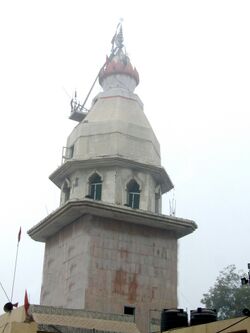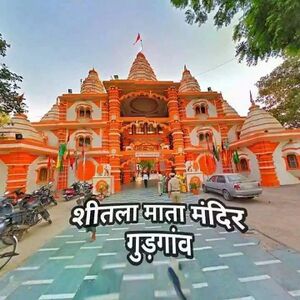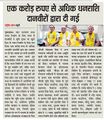Gurgaon

Gurgaon (गुडगाँव) is a city and district in Haryana. Its anciant name was Gudapura (गुड़पुर)[1]. The district headquarter is situated in Gurgaon city. Other smaller towns are Nuh, Ferozepur Jhirka, Sohna, and Pataudi. Total area of the district is 2,105 sq km and its population is 11,46,000. City has been renamed as Gurugrama (गुरुग्राम) after its ancient name of Mahabharata period.
Variants
- Gurgaon (गुड़गांव) (हरियाणा) (AS, p.290)
- Gudapura (गुड़पुर)
- Gurugrama (गुरुग्राम) = Gurgaon (गुड़गांव) (AS, p.292)
Location
Village Gurgaon is situated in the centre of the city Gurgaon. It has a great history, related to the time of Mahabharata. Village Gurgaon formerly was also known as Gurugrama (गुरुग्राम) after the name of Guru Dronacharya. The Great Sheetla Mata Dham is also situated in Gurgaon Village. People from all over the India come to this temple.
Tahsils in Gurgaon district
- Gurgaon
- Pataudi
- Sohna
- Farrukhnagar
- Manesar
- Badshahpur Gurgaon,
- Harsaru,
- Kadipur Gurgaon,
- Wazirabad Gurgaon
Villages in Gurgaon tahsil
- Note - In Gurugram district, several new tahsils have been created and many villages which were earlier part of Gurugram tahsil, have been allotted to those tahsils. So, if you do not find a village's name here, please see concerned tahsil's village-list.
Allawardi, Babupur, Bajghera, Basai, Begampur Khatola, Cartarpuri Alias Daulatpur Nasirabad, Choma Khera, Danokri, Daulatabad, Dhankot, Dhanwanpur, Dharampur, Duman, Dundahera (CT), Fazalwas, Garoli Kalan, Garoli Khurd, Gurgaon Village Inayatpur, Jataula, Kadipur, Khandsa, Kharki Majra Dhankot, Khawaspur, Mohammadpur Jharsa, Mohmadheri, Molahera, Naharpur Rupa, Narsinghpur Gurugram, Navrangpur, Nawada Fatehpur, Pathrari, Pawala Khasrupur, Rathiwas, Sarhol, Shahpur, Sihi, Sukhrali,
Gurgaon City
Gurgaon (गुड़गांव) is the sixth largest city in the Indian state of Haryana. According to 2007 India census, Gurgaon has a population of 2 million.[2] Gurgaon has grown extensively during the last decade due to its proximity to Delhi and emergence as a major outsourcing destination and real estate market in northern India.
An important town in ancient Hindu mythology, Gurgaon is one of Delhi's four major satellite cities and is therefore considered to be a part of the National Capital Region of India.
Mention by Panini
Guda (गुड), Var. Gudā (गुडा) is a place name mentioned by Panini under Ashmadi (अश्मादि) (4.2.80.8) group. [3]
History

The origins of the city's name are steeped in Hindu mythology. Legend has it that Gurgaon is the ancestral village of Guru Dronacharya, the teacher of the Pandavas and Kauravas in the Indian epic, Mahabharata. In the ancient times, the name Gurgaon was originally said to be "Guru-Gram". In the original Sanskrit language, Guru means "teacher", which in this case refers to (Guru Dronacharya) and Gram means a (village). The village was gifted by the Pandavas and Kauravas to their Guru Dronacharya, and was therefore known as Guru - Gram, (Village of the Guru). The sanskriticised "gram" was over a period of time rounded off to a colloquial "gaon" and hence the name to Gurgaon. But some believe that Yudhisthira gave this land to Guru Dronacharya for teaching warfare and use of arms to the five Pandavas when they were young. This was the place where Dronacharya taught archery to the Pandavas.
Since the Aryan migration through current times Gurgaon is dominated by the Jats race. Jats, like the citizens of ancient Roman alternated between farming and fighting for their lands in this part of the world for centuries. This fierce race had been the buffer by default shielding Hindus from foreign Islamic invasions from the west since the past ten centuries. Jats have cultivated and protected the lands in and between 'Punjab region' and 'doab' (two rivers Yamuna and Ganga - this region today includes New Delhi, Haryana, Punjab, Rajasthan, Gujarat, Himachal Pradesh, Uttar Pradesh, Uttaranchal, Pakistani Punjab, Pakistani Sindh). Research conducted during the British rule identified Jats as an integral and vital part of the history of India. In the Punjab region and present day Haryana Jats had long cultivated the lands and ardently protected the inhabitants ('Chattis Kaum' - thirty six communities) against the Islamic invasions from time to time. In addition, to the Jats today Gurgaon is inhabited by Ahirs, Gujars, Punjabis and a growing expatriot population from overseas.

Maa Sheetla Mata Temple, Gurugram ( Haryana) Built by Sinsinwar ruler Maharaja Jawahar Singh of Bharatpur.
गुड़गांव
विजयेन्द्र कुमार माथुर[4] ने लेख किया है ...गुड़गांव (हरियाणा) (AS, p.290) कहा जाता है कि महाभारत काल में राजा युधिष्ठिर ने गुड़गाँव को अपने धर्मगुरु द्रोणाचार्य को उपहार स्वरूप दिया था. द्रोणाचार्य के नाम पर इसका नाम गुरुग्राम पड़ा था। बाद में समय के साथ इसका नाम गुडगांव हो गया। द्रोणाचार्य का एक मंदिर भी गुड़गांव में है.
गुड़गांव परिचय
गुड़गाँव शहर, दक्षिण-पूर्व हरियाणा राज्य, पश्चिमोत्तर भारत में स्थित है। गुड़गाँव बहुत ही ख़ूबसूरत स्थान है। इसके उत्तर में रोहतक और दिल्ली, पूर्व में फ़रीदाबाद और दक्षिण में उत्तर प्रदेश स्थित है। गुड़गाँव की स्थापना 15 अगस्त 1979 ई. को की गई थी।
जाट भवन गुड़गांव का भूमि पूजन
जाट कल्याण सभा गुड़गांव द्वारा जाट भवन गुड़गांव का भूमि पूजन दिनांक 16 जून 2024 को किया गया है.
कार्यक्रम का वीडियो देखें - जाट कल्याण सभा द्वारा सेक्टर-10 मे जाट भवन निर्माण के भूमि पूजन कार्यक्रम का हुआ आयोजन
Jat Gotras in Gurgaon district
See the List of Jat Gotras in Gurgaon district
Notable persons

- Randhir Singh Janghu (Naik), SM, martyred on 14.10.1987 during Operation Pawan in Sri Lanka. He was from Daulatabad in Gurgaon district of Haryana. Main road of village Daulatabad is named after Shaheed Randhir Singh Janghu by Haryana Govt.

- Kartar Singh Kataria (Havildar) became martyr on 01.11.1971 in Bangladesh during Indo-Pak War 1971 fighting with Pakistan Army. He was from Gurgaon. A road near Fire Station in Gurgaon is named after him.
- Unit: 2 Jat Regiment

- श्री अशोक सिहाग गुरुग्राम के सेक्टर 51 में रहते हैं। सामाजिक सहयोग की इनकी भावना के लिए बहुत बधाई।इन्होंने छोटू राम धाम जसिया में भी दो कमरे यानि रु 801000/ का दान दे रखा है।अपने सुसर चौधरी ओम प्रकाश से एक कमरा तथा धाम में सबसे बड़े दानी चौधरी राकेश जून मालिक HL सिटी बहादुरगढ़ से रु1करोड़ 25लाख दिलवाने में महत्वपूर्ण भूमिका निभाई हुई है।
ऐसे ही लोगों से सामाजिक सरोकार पूरे होते हैं।
External Links
References
- ↑ "Early Chauhan Dynasties" by Dasharatha Sharma, pp. 82
- ↑ 2001 census figures - official website of Gurgaon
- ↑ V. S. Agrawala: India as Known to Panini, 1953, p.501
- ↑ Aitihasik Sthanavali by Vijayendra Kumar Mathur, p.290
Back to Jat Villages Haryana





